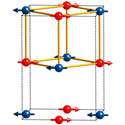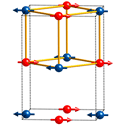Magnetic order in a “hot” material
Strontium metal oxides exhibit a diverse range of electronic and magnetic properties. Strontium molybdate ( ) is paramagnetic and has one of the highest conductivities of the metal oxides, while strontium ruthenate ( ) is a metallic ferromagnet with a transition temperature around . Between molybdenum and ruthenium in the periodic table lies technetium ( ), and strontium oxides based on this element should also exhibit interesting properties. Unfortunately, technetium does not have a stable isotope, which has so far hampered the exploration of materials based on this fourth-row transition-metal element. Now, writing in Physical Review Letters, Efrain Rodriguez at the NIST Center for Neutron Research in Maryland, US, and collaborators in the US, Australia, and the UK report a first comprehensive magnetic study of , a compound that turns out to differ greatly from its strontium metal oxide cousins.
While having a similar structure to strontium molybdate and ruthenate, stands out both because it is antiferromagnetic, and because it has the highest antiferromagnetic ordering temperature (roughly ) obtained in a material without a third-row transition metal—much higher than the analogous antiferromagnet strontium manganite ( ). Rodriguez et al. argue that the comparatively greater hybridization that occurs between technetium and oxygen, the smaller energy splitting between the electronic orbitals on the technetium cation, and the suppression of competing antiferromagnetic states account for the higher ordering temperature they observe. – Daniel Ucko





